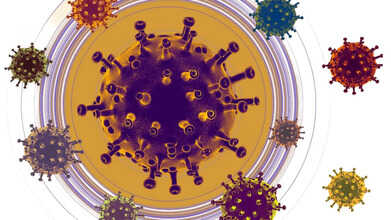- Health Conditions A-Z
- Health & Wellness
- Nutrition
- Fitness
- Health News
- Ayurveda
- Videos
- Medicine A-Z
- Parenting
- Web Stories
NHS Launches New Test To Detect THIS Rare Genetic Condition in Newborns

Credits: Canva
Newborn babies in England will now be routinely screened for a rare genetic condition, NHS England has announced. This condition will be included in the standard blood test that babies receive on the fifth day after birth, collected from the heel. The screening will focus on Hereditary Tyrosinaemia Type 1 (HT1), a disorder that can lead to serious health issues if left untreated. Below, we explain what this condition is, its symptoms, potential severity, and more.
What Is Tyrosinaemia Type 1 (HT1)?
Hereditary tyrosinaemia type 1 (HT1) affects about one in every seven UK babies each year and can cause lasting health problems if not treated early. The condition stops the body from properly breaking down protein, causing toxic substances to build up in the blood. This important screening will now form part of the routine blood spot test, taken from a newborn’s heel on the fifth day after birth.
Tyrosinaemia Type 1 (HT1) is a rare, serious inherited disorder that affects metabolism. It prevents the body from processing the amino acid tyrosine due to a missing enzyme called fumarylacetoacetate hydrolase (FAH). Without this enzyme, harmful byproducts accumulate in the liver, kidneys, and nervous system, potentially causing severe liver and kidney disease, and increasing the risk of liver cancer if untreated.
Tyrosinaemia Type 1 (HT1) Early Signs
Early signs in babies can include poor growth, vomiting, diarrhoea, yellowing of the skin or eyes (jaundice), and an enlarged liver. If left untreated, later complications may involve weakened bones (rickets), neurological problems, and liver cancer.
In HT1, the missing enzyme fumarylacetoacetate hydrolase leads to a buildup of a harmful substance called succinylacetone (SUAC), which interferes with the body’s ability to process tyrosine.
Dr. Harrison Carter, NHS director of vaccination and screening, said: “Being able to screen for tyrosinaemia gives thousands of families extra reassurance. While most babies will not have a genetic condition, for those who do, early detection means treatment can start immediately, giving the baby a better chance at a healthy life.”
Once identified through the NHS screening, babies with HT1 can be treated with a medication called Nitisinone, which helps prevent high levels of tyrosine in the blood.
Tyrosinaemia Type 1 (HT1) Symptoms
According to the National Organization for Rare Disorders, HT1 symptoms in babies include poor growth, jaundice, enlarged liver and spleen, and a distinctive cabbage-like odor. In older children and adults, the condition can cause liver and kidney failure, bone weakening (rickets), bleeding problems, and neurological issues such as seizures or behavioral difficulties.
- Acute form (infancy)
- Difficulty gaining weight and growing (failure to thrive)
- Yellowing of the skin and eyes (jaundice)
- Enlarged liver and spleen
- Swollen abdomen
- Increased tendency to bleed (for example, nosebleeds)
- Vomiting and diarrhea
- Fever
- Chronic form (after 6 months to 2 years)
- Gradual development of liver and kidney problems
- Liver cirrhosis and nodules
- Softening of bones (rickets)
- Neurological complications
- Mild to moderate liver disease
- Later-stage and adult symptoms
- Severe liver and kidney damage or failure
- Higher risk of liver cancer
- Neurological issues such as intellectual disability, seizures, or psychiatric disorders
- Peripheral neuropathy
- Kidney dysfunction or failure
The HT1 test has been added to the NHS Newborn Blood Spot Screening Programme following a recommendation from the UK National Screening Committee.
Kristen Storms, General Hospital Star Opens Up About Her Brain Aneurysm

Credits: Instagram @kirstenstorms
"My brain seems to be sorta lowkey rebelling against me," says the General Hospital star Kristen Storms who revealed that she will soon be undergoing a surgery to treat her brain aneurysm.
The 41-year-old ABC soap opera star on October 14 shared her healthy journey in a candid Instagram post, revealing that she had discovered about her condition in a recent medical scan.
A New Discovery During A Typical Scan
She explained that while doing a follow-up scan for the cyst she had removed from her brain in 2021, she discovered aneurysm on the right side. “While undergoing a follow-up scan for the cyst, my neurosurgeon discovered an aneurysm on the right side,” she wrote.
In January, she underwent a procedure in which doctors threaded a tiny camera from her leg up to her brain, a process she humorously described as “insane.” “It’s a routine procedure, but the path inside your body that they lead the camera through is wild,” she said. “THE CAMERA GOES THROUGH YOUR ARMPIT, guys. Your. Armpit.”
However, due to the complexity of her case, the doctors did not perform the surgery.
What Is Coiling? How Does It Treat Brain Aneurysm?
A brain aneurysm is a weak, bulging area on the wall of a blood vessel in the brain that can resemble a balloon or blister. Most brain aneurysms cause no symptoms until they rupture, which can lead to a life-threatening hemorrhage (bleeding) called a subarachnoid hemorrhage (SAH). Rupture can result in stroke, brain damage, coma, or death, making a ruptured aneurysm a medical emergency that requires immediate treatment.
According to Johns Hopkins Medicine, coiling is a minimally invasive procedure used to block blood flow to an aneurysm. By placing soft platinum coils, which are thinner than a strand of hair, into the bulging artery, doctors can prevent it from rupturing. If left untreated, a burst aneurysm can lead to brain damage or even be fatal.
Storms shared that her coiling procedure is now being scheduled within the next two weeks. To calm her nerves while she waits, she’s been spending time with her close friend and former co-star Emme Rylan (who played Lulu on General Hospital), “crocheting the most beautiful sweaters,” as she put it.
A Life Changing Moment
"Aneurysms (obviously) can be caused by stress. It was clear I needed to change some things in my life asap. For my own personal reasons, no longer living in Los Angeles was very important to me. The biggest reason was Harper, but also for my physical and mental health. And my overall happiness," she wrote.
Earlier this year, Storms took a break from General Hospital and relocated to Nashville with her 11-year-old daughter, Harper.
In her post she also addressed false rumor around her hospital visits when someone had spread a rumor that Storms was hospitalized for a suicide attempt. "I couldn’t understand why a person would make up something that terrible when they had no idea why I was really there,” she said.
However, despite all this, she keeps a positive and a hopeful attitude, which also showed in her message that read: “There are a few really bad apples out there. But there are people in my life who I am truly thankful to know. One of those individuals just made a sh*t load of sweaters with me. They are glorious.”
She ended the note with: "“Even though my brain seems to be sorta lowkey rebelling against me, we’ve all got times when things aren’t great. If we can, we’ll do our best for ourselves and our loved ones.”
Nick Mangold, Ex-Jets Star, Makes A Public Appeal From His Fans For Kidney Donor, Details Inside

Credits: Wikimedia Commons and Canva
Former New York Jets center and offensive lineman Nick Mangold, a legend, is asking for donors for his kidney transplant. Now, 41, in a letter to the Jets community, Mangold said that in 2006 he was diagnosed with a genetic defect that has caused him a chronic kidney disease and he is going through a "touch stretch".
He shared on social media on Tuesday: "In 2006, I was diagnosed with a genetic defect that has led to chronic kidney disease. After a rough summer, I'm undergoing dialysis as we look for a kidney transplant. I always knew this day would come, but I thought I would have had more time."
His letter further mentioned: "Unfortunately, I do not have any family able to donate at this time, so this is why I'm reaching out to you, our NY Jets community. I am in need of a kidney donor with type O blood. If you are willing to find out if you could be a match and donate a kidney to me please go to this site https://columbiasurgery.org/kidney-transplant and click the link I WANT TO DONATE MY KIDNEY."
He wrote that none of his family members are able to donate a kidney, and thus he is looking for the same from his fans. Despite the health struggles, Mangold is staying positive and focusing on the path ahead.
He spent his entire 11-year NFL career with the Jets and is currently a member of the Jets Ring of Honor.
He signed his letter off with a hopeful message, "I am looking forward to better days and getting back to full strength soon. I will see you all at MetLife Stadium very soon."
How To Become A Living Kidney Donor?
The National Kidney Foundation notes that the first criteria is that you must be at least 18 years of age to be able to donate your kidney. However, some transplants require you to be 21 or even slightly older.
However, kidney donation, writes Dr Shyam Bihari Bansal from the Department of Renal Care at Medanta, age typically ranges between 18 to 65. "However age alone does not disqualify someone from donating. Older individuals can still donate if they are in good health and pass the necessary medical evaluations."
A Potential Donor Undergoes A Medical Evaluation
Potential donors undergo an extensive medical and psychological evaluations to ensure that they are physically and mentally fit. What do these evaluations include? These processes include a comprehensive physical examination, blood tests, imaging studies, and consultations with various healthcare professionals.
Other health requirements like a fit and healthy body without any chronic medical conditions like hypertension, diabetes, or kidney disease is what makes the person further eligible for kidney donation.
Certain lifestyle habits are also taken into consideration like smoking, substance abuse, and obesity. Dr Shyam Bihari Bansal writes, "Donors are usually required to abstain from smoking and illicit substances and maintain a healthy body mass index (BMI) before proceeding with donation."
The most important part is that the blood type compatibility between the donor and recipient must match. The donor's kidney function is evaluated through blood tests and a 24-hour urine collection is done. These tests help determine if donor's remaining kidney is helpful.
‘Frankenstein’ COVID-19 Variant Hits Canada; Precautions You Should Take

Credits: Canva
There’s a new variant of COVID-19 spreading, nicknamed “Frankenstein,” and it has now been detected in Canada. The strain, officially known as XFG, is part of the Omicron family and earned its nickname because it combines genetic material from two Omicron subvariants.
‘Frankenstein’ COVID-19 Variant Hits Canada
“As of October 2025, XFG (sometimes referred to as the ‘stratus’ or ‘Frankenstein’ variant) is the most common COVID-19 variant in Canada, according to the weekly variant breakdown and the wastewater monitoring dashboard,” the Public Health Agency of Canada (PHAC) said in an email. The agency categorized XFG as a “variant under monitoring” and confirmed that Canadian scientists are closely watching its spread and potential impact.
Should You Be Worried About The Frankenstein Strain In Canada?
PHAC noted that while most COVID-19 indicators are rising nationally, trends differ by province and territory. “At this time, there is no evidence that the currently circulating COVID-19 variants in Canada are causing more severe illness,” the agency said. Interestingly, the Frankenstein variant has also appeared in countries such as the U.S., U.K., and France, and authorities there have indicated it is not particularly dangerous and can be managed with standard precautions.
What Is The Frankenstein Variant?
The World Health Organization (WHO) says that recent increases in COVID-19 cases are linked to a new variant called XFG, nicknamed “Frankenstein” because it is a recombinant virus, meaning it carries genetic material from two subtypes: LF.7 and LP.8.1.2. The WHO has been tracking XFG since June 25, 2025, and it has now been found in several countries. Current evidence suggests that the overall public health risk remains low, and existing COVID-19 vaccines are expected to continue preventing severe illness and symptomatic infection.
Precautions To Stay Safe From Frankenstein Variant
During the respiratory illness season, PHAC reminds everyone to stay current on recommended vaccines, including those for seasonal flu, COVID-19, and respiratory syncytial virus (RSV).
“These vaccines offer strong protection against serious illness. Check with your healthcare provider or local public health authority about which vaccines are right for you,” the agency advised.
Additionally, individuals can take personal measures to reduce the risk of catching or spreading respiratory illnesses.
PHAC explained that infectious diseases can spread through person-to-person contact or via contaminated surfaces, so using multiple precautions together is most effective.
Personal protective measures include:
- Staying home when feeling unwell
- Wearing a well-fitting mask or respirator when appropriate, including: if you are sick and need to be around others; during seasons when respiratory illnesses are more common, such as fall and winter; in closed or crowded spaces; and if you have personal risk factors (for example, higher risk for serious complications, or frequent contact with vulnerable people such as older adults, young children, pregnant individuals, or those with weakened immune systems)
- Improving ventilation indoors whenever possible
- Washing hands frequently
- Covering coughs and sneezes
- Cleaning and disinfecting high-touch surfaces and objects
© 2024 Bennett, Coleman & Company Limited

